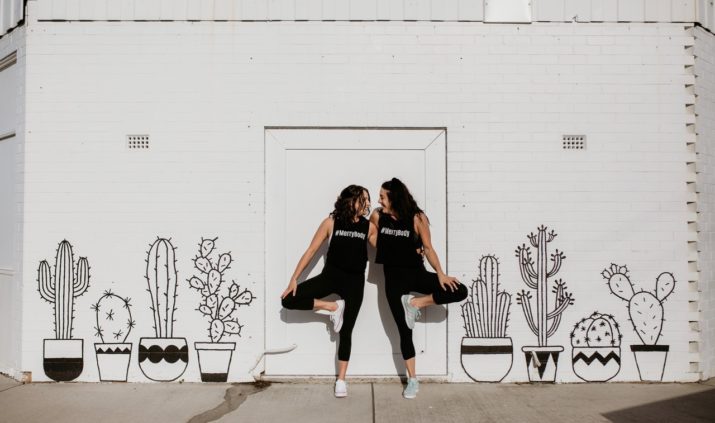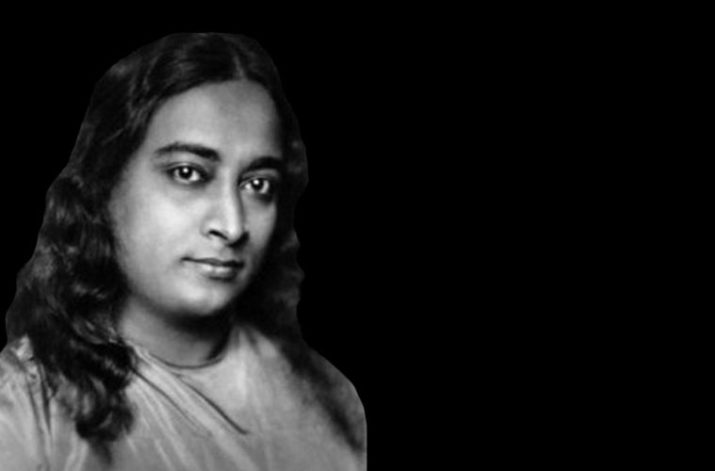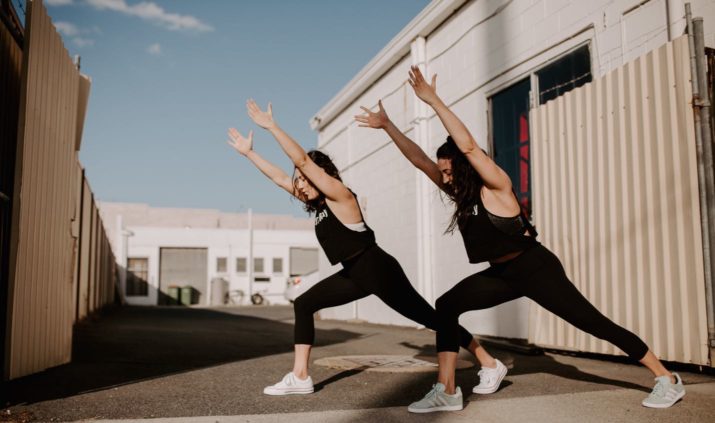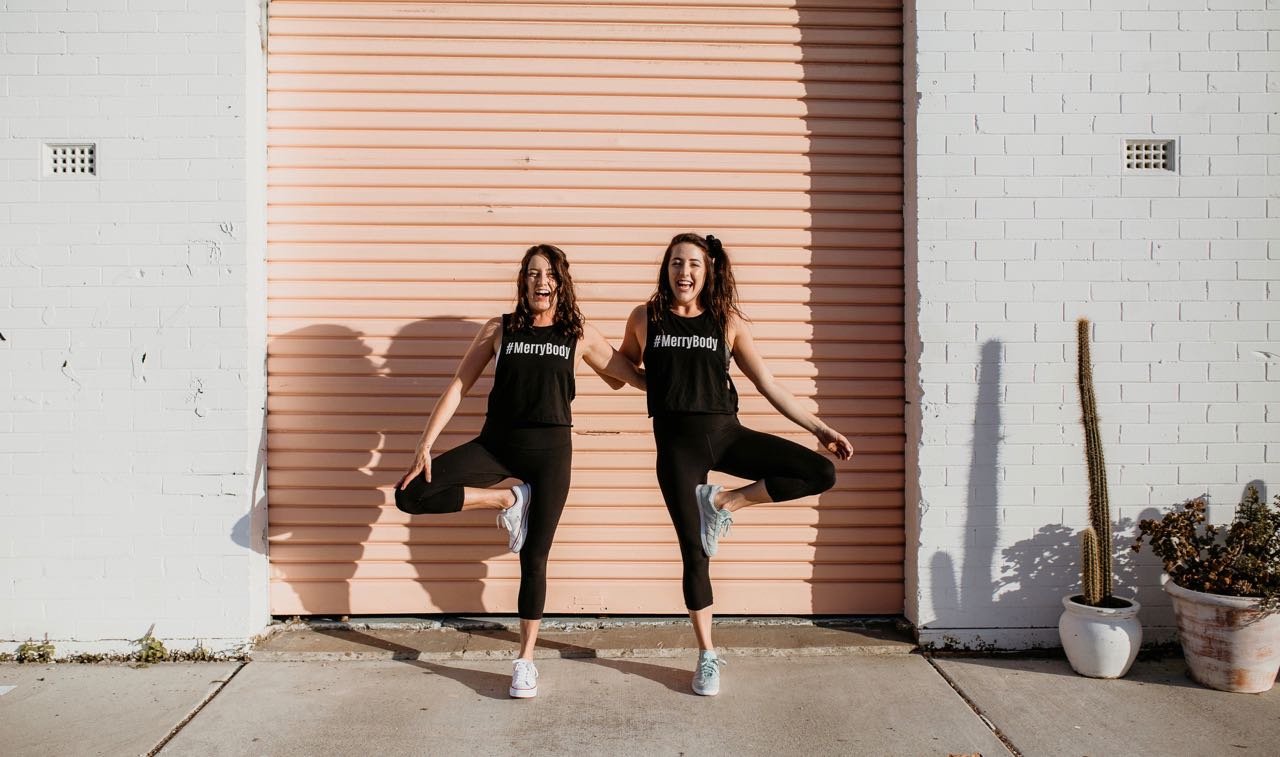Between the both of us, Carla as a Yoga teacher and me (Emma) as a Pilates teacher, we often get asked, what is the difference between Yoga and Pilates? They are both methods of exercise that connect to breath, they both focus on presence… but they are very different.
And we believe it’s the combination of both Yoga and Pilates that welcomes the most epic mind, body and soul transformation.
Yoga and Pilates completely transformed our lives. We’d both spent years and years at war with our bodies, through dieting, eating disorders and using exercise as a form of punishment (to burn the calories from the weekend indulgences).
But no matter how much weight we lost, then gained, then lost, then gained… we were never happy.
Through our journey with Yoga, Pilates and Meditation we realised the only thing that truly mattered was how we felt about ourselves right NOW.
Yoga and Pilates created more strength, they’re great for muscle toning, and flexibility BUT there is so so so much more to these practices. We’re so grateful we found them and this is why we created MerryBody. Whether you choose Yoga or Pilates or both we know you’ll experience great benefits!
What is the difference between Yoga and Pilates?
Let’s start at the very beginning, a very good place to start…
A brief history of Yoga | The benefits of Yoga.
Everyone’s idea of Yoga is different, everyone’s Yoga looks different. There are so many different styles and types of Yoga plus each and every Yoga instructor brings their own flair.
Yoga is recognised as an ancient system of practices, philosophies, and principles that can be traced back to 5000, even 10000 years ago. Derived from Vedic tradition of India and the Himalayas.
So we’d like to emphasise the BRIEF history of Yoga here (haha).
We’ve read Yoga books, articles, watched documentaries and everyone’s history, opinion and meaning of Yoga is different and obviously, over the thousands of years it has changed and evolved significantly.
We liked how Yoga Basics described the history of Yoga.
Today’s western-style Yoga is known as the Asana practice… this is the movement, the exercise we know as Yoga. But thousands of years ago Yoga was more a philosophy, a set of values, a way of life… a state of being.
The word Yoga was first mentioned in the Rig Veda, sacred and very old texts. The Vedas were a collection of songs, mantras and rituals. Used by Brahmans, the Vedic priests.
Yoga was slowly refined and developed by the Brahmans and Rishis (mystic seers) who documented their practices and beliefs in the Upanishads, a huge work containing over 200 scriptures.
The most renowned of the Yogic scriptures is the Bhagavad-Gita, created around 500 B.C.E. It’s the teaching of the sacrifice of the ego through self-knowledge, action (karma yoga) and wisdom (jnana yoga).
There are many translations of this text, it’s a beautiful book, poetry… words for the soul. If you are interested in Yoga Philopshy we highly recommend that you read it (if you’d like to know our favourite translation, ask us on social media or email!).

CLASSICAL YOGA
The next stage of Yoga is often known as Classical Yoga. It is Patanjali’s Yoga-Sutras, the first systematic approach of Yoga.
This text describes the path of Raja Yoga or Classical Yoga.
Patanjali outlined the practice of yoga into an eight limbed path, they are the steps and stages towards obtaining enlightenment or Samadhi.
Patanjali is known as the father of Yoga, his Yoga-Sutras influenced most styles of modern yoga.
POST CLASSICAL YOGA
A few centuries following Patanjali’s Yoga-Sutras, Yoga masters focused on the physical body to create enlightenment.
It was all about rejuvenating the body and prolonging life.
This was when Tantra Yoga was developed, with sometimes radical techniques to cleanse the body and mind. The word tantra means to weave and expand, it’s about disconnecting to the physical existence. And this is what led to Hatha Yoga… what most of us know as Yoga today.
MODERN YOGA
In the late 1800s and early 1900s, yoga travelled to the West.
Swami Vivekananda was the first person to bring Yoga to America, by running lectures at the 1893 Parliament of Religions in Chicago USA.
In the 1920s and 30s, Hatha Yoga was strongly promoted in India with the work of T. Krishnamacharya, Swami Sivananda and other yogis practising Hatha Yoga.
Krishnamacharya opened the first Hatha Yoga school in Mysore in 1924 and in 1936 Sivananda founded the Divine Life Society on the banks of the holy Ganges River.
Krishnamacharya led three students that would continue sharing Yoga with the West and increase the popularity of Hatha Yoga: B.K.S. Iyengar, T.K.V. Desikachar and Pattabhi Jois.
Paramahansa Yogananda, was also on a similar mission to bring Yoga to the West. Also the author of the very well known book Autobiography of a Yogi.
More and more people started practising this form of Yoga, more studios opened (and continue to).

Image via: I am a fearless soul
And so it continues! According to the International Yoga Federation, there are about 300 million people who practice Yoga in the world!
As modern life becomes more busy people are seeking ways to calm the mind and also create and cultivate optimal physical and mental health. The popularity of Yoga continues to rise and rise.
From hot Yoga, to Yin Yoga and fast paced flow Yoga classes, you will find something you like!
When you create a consistent Yoga practice, you will gain flexibility, get stronger and tone your body.
Yoga is not just a physical practice, this is just scraping the surface. Yes, in Yoga you hold poses but really Yoga is a practice for your mind, it’s for your heart and your soul. It helps you feel present, it helps you connect to yourself and feel gratitude for all you have.
Each class is an opportunity to learn something new about yourself and the world.
Yoga connects mind, body and breath.
We see Yoga as a method to awaken the soul, to connect to your intuition, your truth and it creates peace within.
Yoga Asana, the physical practise includes many postures and movements, depending on your Yoga teacher, you’ll experience something different at every class, as the sequences are creatively put together. You’ll find yourself standing, bending, twisting, folding, lying, reaching, flowing… and sometimes (depending on the type of class), sweating! You’ll use your body weight and create strength, you might practice slower or even Yin Yoga and welcome in more flexibility.
For us, Yoga is a non-negotiable almost daily habit. We simply feel better when we practise Yoga.
We feel like we can handle the ups and downs of life with more ease. We feel more contentment and more gratitude! Ahhh, it’s pure magic. In MerryBody we practise Hatha Yoga, with styles like Vinyasa and Yin.
READ MORE: What Yoga does to your brain (it’s fascinating!)
READ MORE: How Yoga changed our bodies.
A brief history of Pilates | The benefits of Pilates.
Pilates was created by Joseph Pilates, he referred to his method of exercise as ‘Contrology’. He developed this exercise practice in the early 20th century, inspired during World War 1 while he was being held in an internment camp.
Through time, his students began to refer to Contrology as ‘Pilates’.
“Contrology is the complete coordination of the body, mind and spirit.”
Pilates believed that to be healthy and for people to reach their full potential in life, both physical and mental conditioning was required.
The method of Contrology involves low impact exercises. Think controlled, precise, repeated movement. With a concentration on body positioning and alignment, it’s known to correct poor posture, therefore preventing body ailments caused by years of bad posture.
With many people sitting more and moving less due to different reasons, this form of exercise is required now more than ever.
This sedentary lifestyle is not only bad for health and general wellbeing it is linked to the cause of many serious mental and physical illnesses.
As recommended by Joseph Pilates, if individuals practise the Contrology (Pilates) method 4 times a week, it will impact all other aspects of life in a positive way.
Over the years Pilates has changed significantly. But the foundations that Joseph Pilates identified throughout his texts are still the basis of the modern day practice of Pilates.
The principles of Pilates differ from school to school and studio to studio, teacher to teacher but they are all based on Joseph Pilates’ original system and foundations.

Here are the 6 principles of Pilates…
BREATH
Joseph Pilates paid particular attention to the breath (he probably was influenced by Yoga). He saw the breath as a way to re-energise, cleanse and invigorate the body and mind.
In Pilates, we breathe out with the effort within each movement and in on the return. In our MerryBody Pilates classes, you’ll hear us be quite forceful with the breath, making a ‘shhh’ sound. This helps to engage the core muscles and pelvic floor muscles.
The cross over with Yoga here with the power of the breath can be linked to Patanjali’s 8 Limbed Path, with the 4th limb being Pranayama, which translates to lifeforce control, where the action is control of the breath. Pranayama is a collection of breath techniques all designed to affect the body and mind differently. For example, one practise encourages the balance of the mind and body, another encourages energy, another creates groundedness.
In our MerryBody Yoga classes, we often use Pranayama at the beginning of our Yoga classes. Our breath during the classes is always a deep inhale through the nose and long exhale through the nose. This technique is known to calm the body and actually switch on the Parasympathetic Nervous system, rest and digest, repair and restore.
CONCENTRATION
Concentration is the direction of attention to a single objective. In Pilates it’s the awareness of the breath, a focus on the movement of the body. Taking note of what muscles are being worked and the body’s alignment.
It’s about being there in the practice, not letting the mind wander to the future or the past eg. work, what’s for dinner or daydreaming of morning coffee (don’t worry we still do this… this is why we call it a practise).
Without this concentration, Pilates movements lose integrity, with less effective results.
Again, there is a cross over here with Yoga. In Yoga we call this Drishti. One pointed focus. Whether that be an internal focus or intention, or something external like the horizon or your big toe!
CENTRE
In Pilates movements, we focus on working from the centre. This is why we pay close attention to the core and building core strength. During Pilates classes, you might often hear a reference to the powerhouse muscles.
The muscles of the powerhouse include abdominals, hips, upper and lower back, inner thighs and buttocks. These are the main muscles used in Pilates. Every other muscle is an extension from these muscle powerhouse muscles. The powerhouse muscles are the foundation to great Pilates technique and results.
Focusing on these muscles improves posture and will reduce the risk of injuries.
Centre can also refer to the centre of gravity of each individual, which is different for everyone. Understanding this allows us to realise that we are all built slightly different and therefore movements might look and feel slightly different.
CONTROL
Control is the refinement of the Pilates method, it’s about practising regularly to improve technique and therefore creating more effective results. Control is more important than speed and intensity, especially when you first begin.
This is why we ALWAYS give the advice to our MerryBody Members to slow down if they need to. Get the movement and technique feeling good, then add the speed. This is why we also add modifications to our MerryBody Classes, we focus on building strong foundations allowing better control.
Like many different exercises and movements when we practise Pilates without Control we can, in fact, do more damage than good to the body.
Sign up to our 7 day free trial, try out an Online Yoga and Pilates class today! Join here!
PRECISION
Precision is the way a movement is executed. It’s about activating the correct muscles during the correct movements. This is why Pilates teachers will give you constant reminders on form, in MerryBody you’ll hear us say…
Hold your core strong, point the toes, really extend the leg long, shoulders back… down and relaxed!
These reminders help us be more precise with movements… and not floppy, sloppy or lazy.
The same goes for Yoga, well MerryBody Yoga any way! We encourage precision to avoid injury and to ensure it feels good for you.
FLOW
Flow is the continuity of movement with no interruptions. The flow is developed from the regular practise of Pilates. To experience the feeling of flow we welcome the feelings of grace and ease.
You’ll also notice that all principals are linked. To move with precision we need control, to move with control we need presence and concentration. And if we desire to feel that continuous flow we need to practise all principles.
When we focus on these principles we connect the mind, body and breath.
With some forms of Yoga, the idea is to create flowing movement, which too, is a method of control. It’s not about stamping your foot forward, but controlling the sweep through and landing with control. In Yoga, there is a focus on the transition between each movement and almost making it seamless.
Alternatively, in something like a Yin class, the focus is not on control but rather relaxation and surrender.
“One of the major results of Pilates (Contrology) is gaining the mastery of your mind over the complete control of your body”. Rael Isacowitz and Karen Clippinger
We are born with a mind, body connection and it is often forgotten as we get older. Whether it be from work, lifestyle, addiction, depression or other health issues. Pilates has the potential to restore this mind, body connection when practised regularly.
What is better? Mat Pilates or reformer Pilates?
Joseph Pilates developed many apparatus’ including the reformer machine for the practice of Pilates.
All exercises have been adapted for mat work, making Pilates more accessible for everyone. It’s a practice for home, work, it’s perfect while travelling… it can be done anywhere, it’s also more cost-effective.
This is the style of Pilates we do inside the Merrybody Online Studio.
Joseph Pilates puts particular emphasis on the regular and consistent practise of Pilates to receive the real benefits. To uncover and rediscover the mind, body, soul connection.
“Knowledge is of no value unless you put it into practice.” Anton Chekov
To learn something is one thing but to practise it regularly is where the real magic happens. We must do the work, to see the benefit. We must do the work to see the change.
Change requires action and Joseph Pilates adds to this, stating that change requires patience and persistence.
The movements are small, precise with great attention on body alignment. An exercise that has been designed to create body suppleness and natural grace, and when practised mindfully and correctly it’s an exercise that can be maintained for life.
Pilates has changed our physical appearances and mental wellbeing but it did not happen overnight. It took action, patience and persistence. It’s a practice that will never end, it’s now part of our lives
The best way to know the difference between Yoga and Pilates?
Is to simply try both Yoga and Pilates. If you’re in the mood to workout NOW! Try the class below! If you don’t have time now, sign up to our FREE 7 Day MerryBody Trial!
If you have any questions at all, get in touch!
Always merrymaking,
Emma + Carla
ps. If you love the sound of MerryBody check it out HERE and sign up to your free 7 Day Trial!


